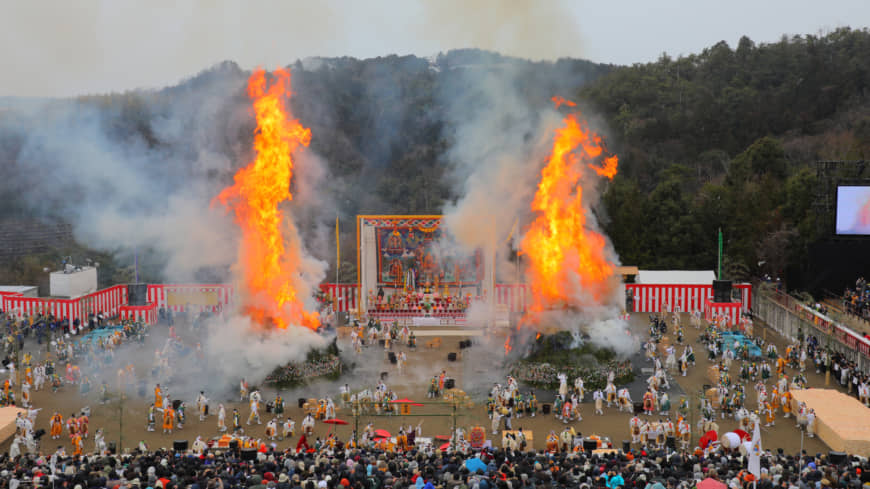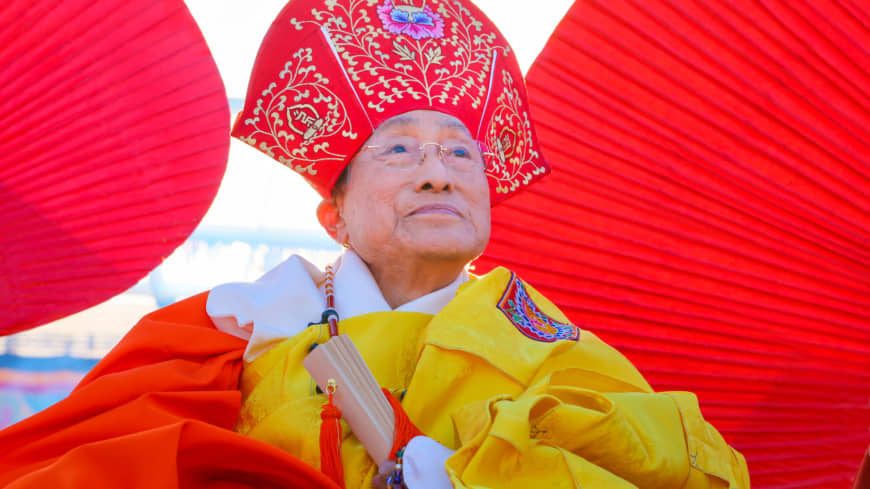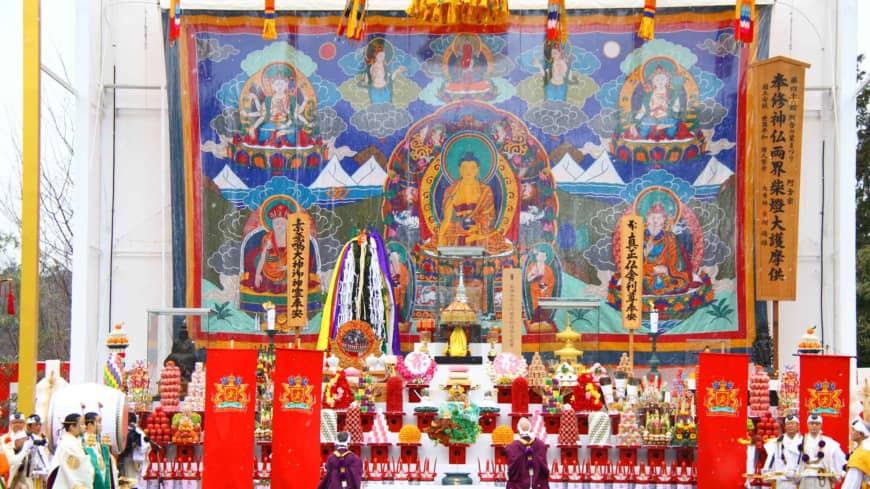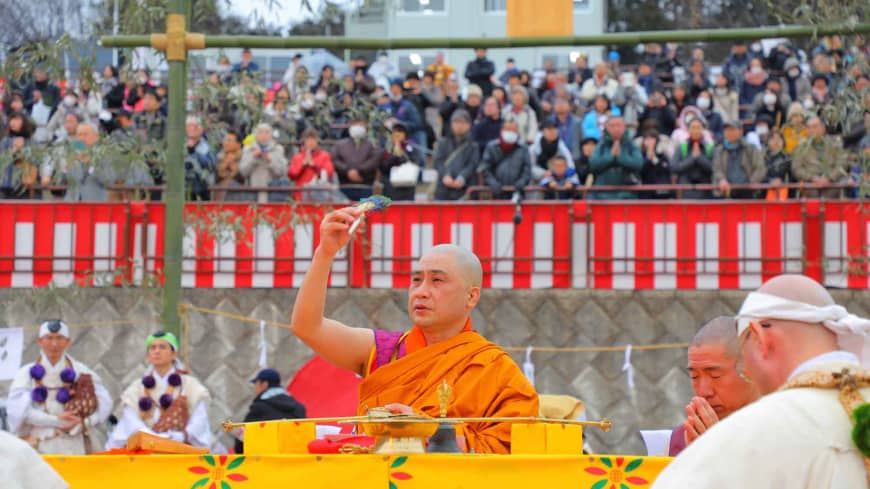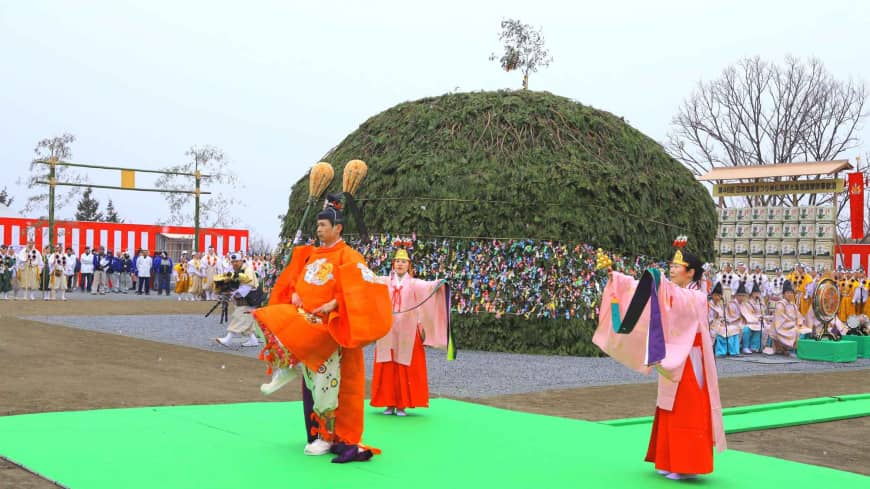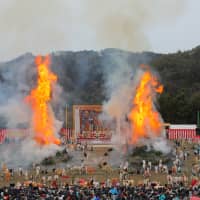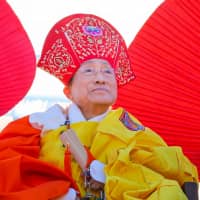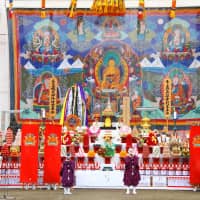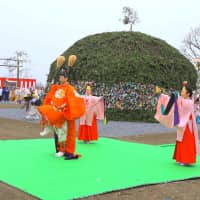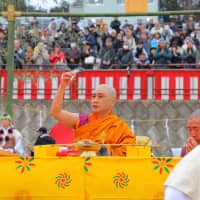People attending the Agon Shu Buddhist Association’s Fire Rites Festival on Feb. 11 saw something unusual as they made their way up the winding road to the site of the annual ritual in the hills east of Kyoto. Fallen trees lay everywhere on the mountain slopes, testimony to the tremendous force of Typhoon Jebi that struck western Japan last September. It was the biggest typhoon to hit the country in 25 years. Thirteen people died, many others were injured and there was widespread property damage.
Jebi and a string of other natural calamities, including a devastating earthquake in Hokkaido, a deadly summer heatwave and floods in western Japan, caused “disaster” to be chosen as the kanji character defining 2018 in a nationwide poll. That also led Agon Shu to choose disaster preparedness and prevention as one of the themes of this year’s Fire Rites Festival.
Although last year’s tragedies added a somewhat somber undertone to this year’s event, the overall atmosphere was, as always, mainly celebratory. You could see that by looking at the faces of the 400,000 people, comprising Agon Shu members, as well as visitors, who attended the world’s biggest fire rites festival.
Celebration and renewal
In keeping with that spirit of celebration and spiritual renewal, the festival began with multicolored fireworks that offered a welcome contrast to the overcast sky and snow flurries. After the fireworks display, there was something else to watch in the sky above the amphitheater where the fire rites take place: a drone equipped with a camera. Images from the camera were projected on a huge screen to the right of the main altar, providing a special aerial perspective of the day’s events.
The sense of anticipation felt by the crowd increased as a procession of Agon Shu faithful dressed as yamabushi mountain priests filed into the amphitheater. The stirring sounds of a symphony written especially for the festival by the late composer Toshiro Mayuzumi heightened the sense of drama. The centerpiece of the procession was a bier bearing the sacred ashes of the Reverend Seiyu Kiriyama, the association’s founder and president, who passed away in 2016.
Kiriyama founded Agon Shu in 1978 after years of searching for spiritual truth. That led him to the Agama Sutras, the original and purest source of Buddhist wisdom. For Agon Shu believers, the Lord Buddha is the ultimate object of worship. Next come the Buddha’s teachings and training methods, known as the dharma.
‘Complete’ Buddhism
After the first two tenets is the sangha: the community of believers and its leaders. A unique feature of Agon Shu is its syncretism. Besides incorporating teachings and practices from Buddhism’s three main schools, including elements from the Tibetan and Bhutanese traditions — making Agon Shu a “complete” form of Buddhism — the association draws on Japan’s indigenous Shinto tradition.
The yamabushi-costumed faithful took their designated places in front of the huge, richly decorated altar while blowing on conch shells. Some of them then beat out a steady and infectious rhythm on taiko Japanese drums. The soundscape changed again as composer Hideki Togi’s ethereal and spiritually uplifting music, a blend of ancient gagaku court music and New Age stylings, accompanied by dance, filled the air.
Besides the altar, the main visual feature in the amphitheater were two gomadan pyres, each 11 meters wide and seven meters high. One was the bukkaidan, for the liberation of the spirits of the departed, while the other was the shinkaidan, for the prayers, requests and desires of the living. Before the bonfires were lit, a series of sacred rituals were held to ensure the success of the day’s proceedings. Three dancers — two female and one male — wearing brightly colored ancient court costumes performed stately bugaku dance rituals that entranced the crowd.
Archery ritual
Four female archers then shot sacred arrows to east, south, west, north, center and northeast as part of the spiritual cleansing. One cleared the upper row of the bleachers, impressing the gathered crowd.
After a mondō (a question-and-answer exchange on religious doctrine) performed by several of the yamabushi-clad faithful, four huge torches were lit. Attendants inserted them in apertures at the base of the gomadan pyres, and soon thick, gray smoke began to billow out of them. Then came the moment everyone had been waiting for, as vivid orange flames burst forth. Their heat and light filled the amphitheater, dispelling the morning’s wintry gloom.
Attendants began throwing gomagi prayer sticks, on which people had written prayers for world peace and national tranquility, their personal prayers and desires, into the flames. A total of 29 million gomagi were burned in this year’s Fire Rites Festival.
Attendees included monks from Sri Lanka and Bhutan, as well as guests from China.
Memorial ceremony
One of the events Agon Shu is planning for the coming months is a memorial ceremony to honor those who died in the Boshin War of 1868-69. That was a civil war between the forces of the ruling Tokugawa shogunate and those who wanted to return political power to the Imperial court. The Imperial side triumphed, but Agon Shu believes it is important to remember the sacrifices of both sides.
The Boshin War and the Seinan War of 1877 were Japan’s last civil conflicts. Agon Shu hopes the peace and prosperity that followed them will continue in Japan. And, of course, peace and prosperity is what Agon Shu desires for people everywhere, not only in Japan.
Visitors leave magnificent event impressed
Foreign visitors attending the Fire Rites Festival were moved and awed by the spectacular rituals.
“It was really beautiful, because it was such a large bonfire, with all the smoke, the flames, throwing the tablets and the huge stadium,” said Elizabeth Kawahara of Parksville, Canada, who was attending the festival for the first time.
Florian Herve, from a small town in France’s Jura region, was another first-time visitor to the festival. “It’s spectacular, especially being in the middle of such a cultural event,” he said.
Ross Hubeek from Melbourne, Australia, had visited Kyoto before, but had never attended a Fire Rites Festival. “It’s really nice to see the spectacle — it’s amazing,” said Hubeek, adding that he enjoyed seeing something different from the “typical shrines and temples.”
Max Liu, who is also from Melbourne, said: “It’s really impressive. I’ve never seen a bonfire like this before.”



